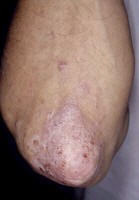Psoriasis symptoms
Dry, red patches of skin are the most well-known symptoms of psoriasis. The skin replaces itself more quickly than normal, causing excess skin cells to pile up in thick layers. Roughly half of people with psoriasis also have irregular fingernail growth that results in pitting, crumbling, or discoloration of the nail. A smaller proportion of people also experience arthritis symptoms.
Psoriasis may begin with small red bumps that eventually grow into large patches of dry skin that flake off in scales. Patches of affected skin often are symmetrical, meaning that they are present in the same place on both sides of the body. Some areas of the body are more likely to be affected, including the scalp, face, arms, hands, legs, groin, feet, and places where the skin folds.
Signs and symptoms of psoriasis
An individual with plaque psoriasis usually has patches of red, raised, scaly areas on the skin that may itch or burn. ?The patches are usually found on the knees, elbows, trunk, or scalp. ? Approximately, 9 out of 10 people with psoriasis have plaque psoriasis.

The flare-ups can last for weeks or months. ?The psoriasis goes away for a time and then returns ?(chronic).
General characteristics of the scaly skin of the most common type of psoriasis are as follows:

Plaques: The plaque areas on the skin are elevated. ?The plaque areas vary in size (1 to several
centimetres) and may range from a few to many at any given time on the skin. ? The shape of the plaque is usually oval but can be irregular in shape. ?Smaller plaque areas may merge with other areas and form a large affected area. ?
The skin in these areas, especially when over joints or on the palms or feet, can split and bleed. ?
Plaque psoriasis with fissures, which are splits in the skin. Fissures usually occur where the skin bends (joints). The skin may bleed and is more susceptible to infection.
Plaques sometimes have an area around them that looks like a halo or ring (Ring of Woronoff).
Red colour: The colour of the affected skin is very distinctive. ?The rich, full red
colour is salmon colored. Sometimes the skin can have a blue tint when the psoriasis is on the legs.
Scale: The scales are dry, thin, and silvery-white. ?The thickness of the scales may vary. ?When the scale is removed, the skin underneath looks smooth, red, and glossy. ? This shiny skin usually has small areas that bleed ?(Auspitz sign).
Symmetry: Psoriatic plaques tend to appear on both sides of the body in the same places. ?For example, the psoriasis is usually on both knees or both elbows at the same time.
Other general symptoms of psoriasis are as follows:
?
Scalp: The scalp can have dry, scaly skin or crusted plaque areas. ?Sometimes psoriasis of the scalp is confused with seborrheic dermatitis. In seborrheic psoriasis, the scales are greasy looking, not dry.

Nails: Nail changes are commonly observed in those with plaque psoriasis. The nails may have small indentations, ridges, or pits in them. The nails can be
discoloured or separate from the nail bed.

Droplets on skin: Sometimes, the skin is red and looks like it has little drops on it. This may be
Guttate psoriasis. ?
Guttate psoriasis. Red drop-like lesions are found on the skin. This type of psoriasis usually occurs after a streptococcal (bacterial) infection.
Pus on patches: Sometimes, the patches of dry, scaly skin can crack and have pus on top of them. This may be pustular psoriasis. ?

Psoriasis in children: Plaque psoriasis looks slightly different in children compared to adults. In children, the plaques are not as thick, and the affected skin is less scaly. Psoriasis may often appear in the diaper region in infancy and in flexural areas in children. The disease more commonly affects the face in children as compared to adults.
Other areas: Although the most common body areas affected are the arms, leg, back, and scalp, psoriasis can be found on any body part. Psoriasis can be found on the genitals or buttocks, under the breasts, or under the arms. ?These areas can feel especially itchy or burning.

products for the treatment of psoriasis
We offer a variety of products for treatment of psoriasis. Please click here to see all products or here for the Dermalight80 for spot treatment of psoriasis. |
